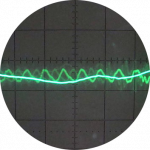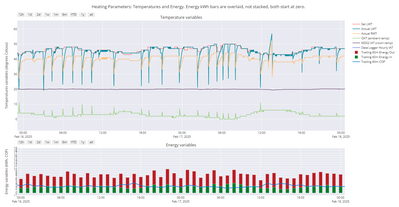@dgclimatecontrol 335 sq meters with some double height ceilings. Variable insulation levels.
@pash44pump Midea has introduced the R290 series, which is more efficient.
I attach the specs so that you can compare performance with current R32 models.
Regarding sizing: since it is quite difficult to correctly size the heat pump beforehand, I would opt for a 16 kW to start with and then add a second unit in cascade, if that was not enough. A second unit can also be handy if something goes wrong with the primary one.
Midea MHCV10WD2N7 R290, 5.8kWp energy community solar power.
@cathoderay How would you suggest I go about collecting energy out data given what you know already about what data collection I can currently do with dataloggers, energy in and COP assumptions?
Do the COP assumptions look reasonable - do you or anyone else have COP numbers at different flow temps, OATs and IATs?
If I go down the route of a third party collection method, what are the recommendations?
Many thanks
@pash44pump - as I said yesterday, see if you can get into the history pages of the Midea app - it should (if I recall right) have hourly and/or daily energy out, and you could use that to sanity check your estimated energy out. @batalto now he has awoken from his slumbers might be able to elaborate.
I think that (and what you are already doing by way of monitoring) is the best you can do with your current set up.
Yes, many of us have COPs under various conditions. The most recent chart I posted of my heat pump during defrost cycles shows all the variables you mention, and more, and I also of course have the underlying data in csv format:
The third party routes I know of are:
(1) Home Assistant, using one or more of its 'integrations' which act as bridges between HA and a device
(2) my DIY approach, using wired modbus (£)
(3) truly independent monitoring using third party hardware (£££), almost certainly overkill in your case
It might be worth having a look at HA, some people think it is wonderful, others (like me) are less enthusiastic, and the only way you will know whether it works for you or not is to try it.
Midea 14kW (for now...) ASHP heating both building and DHW
@cathoderay Thanks. Have you ever seen the attached Midea Engineering Data document? I was stress testing it by getting GPT to find any field data it could and then asking it what "discount" should be applied to the COPs listed. What has your experience of COP v Midea COP claims in their published data? The GPT assumed discount was around 20-25% at lower OATs and that would suggest COPs of 2.5 at a flow 45C and OAT of zero and 3.5 for 40C and 5C OAT respectively. How do they sound relative to your own experience? I've adjusted my assumed COPs on this basis and added some more observations and I'm now getting an assumed HL of 9kw by extraolating the trendline, although my lowest actual temp in the small dataset has been 3C and no prolonged cold periods. Not wishing for cold weather or anything!
Regards
@pash44pump - though I realise I am a Canute, I have an aversion to AI, seen it produce rubbish too often, and the main danger, as I see it, is the people who use AI aren't well enough informed to realise it's rubbish, that is why they are using AI in the first place. If you know the answer, why ask AI?
On this particular occasion, did it say how it determined the 'discount' of 20-25% was determined? If it didn't, it's worthless - you can't verify it. If it did, you can have a look and see if it makes sense. Did it say what you discount by 20-25%, ie what the starting point is?
Yes I have seen the Midea Engineering Data document, and the output tables do contain COPs, but I suspect they may be inclined towards 'ideal conditions'.
In my own setup, my COP can halve from around 4 in mild conditions with low flow temps to around 2 in around zero OAT conditions with a high (approaching 50) LWT, see my last chart for this scenario. Overall, this suggests a greater range and larger variation on my setup that the figures you quote.
Quite agree about not wishing cold weather on ourselves!
Midea 14kW (for now...) ASHP heating both building and DHW
@cathoderay I have to disagree with you here. If you ask good questions, you get decent answers and provided you source check then it's just a faster way of getting to the data more quickly. I don't 'believe' the answer but I need some approximation for COPs because (1) I can't get mine directly with my current set-up and (2) I'm pretty sure, as are you, that Midea's datasheet is based on ideal conditions. I'm already using approximations so I'm trying to see if they are reasonable or not.
[Moderator note: I have removed the AI generated content, because it goes against our forum rules (no AI generated content), but tried to leave the discussion about the use of AI, as that is a valid topic for discussion.
I also appreciate that I sort of asked for the AI output, but in fact what I was really after was sources behind the AI response, this being the crux of the matter - can they be verified?- cathodeRay]
They certainly helps me feel comfortable that my assumptions aren't massively incorrect (even if they still may be incorrect). One of the sources is Renewable Heating Hub, so the answers must be right. 😂
Would be interested if others on this forum have compared their COPs at low OAT to their heat pump manufacturers' 'claimed' COPs?
@pash44pump - AI may have its uses (and I sort of allowed for that possibility by saying if you can verify the sources) but I always start from a point of scepticism. I have always been like that. Mediocre teachers have always disliked me, because I would ask but how do I know what you are telling me is true, but good teachers liked me asking the question, because they were asking the same question of themselves.
[Moderator note: what follows is a response to the AI response (which I have just removed, see that post for an explanation) in the previous post. Because removing that AI content interferes with the 'flow' of the comments' I have edited what follows to make it flow better from the previous discussion, and thereby retain the consideration of the validity and usefulness (or not) of AI responses - cathodeRay]
Right, back to verifying the AI findings and souces. I have a copy of the same edition of the Engineering Data manual that it used, and the numbers I see are similar but not the same (checking across the 12, 14 and 16kW variants, still not sure which one you have), but maybe close enough. If that is the case and the LWT only varies between 35 and 45 degrees, then the 'discount' in going from 7/35 degrees (OAT/LWT) to -7/45 degrees is, from the 'ideal conditions' data above (in your post), over 50%, which is considerably more that the AI answer of 20-25%.
The AI response talks about verified field trials, and this is where I really start to struggle. Verified field trials? Verified by who? There are no links to the sources, but google does find what appears to be the first source, the Energy Saving Trust 2013 and 2016 field trials. These somewhat specialised trials are now quite old (started in 2008), latest report in 2016, and heat pumps are have moved on rather a lot in the last decade, and so the EST trials may not be representative of today's installations. More to the point, I can't find any references to 'discounts', EN 14511, let alone the magic 'Real-world seasonal COP ≈ 0.7–0.8 × EN 14511 values' formula used in the AI response in the report. Instead it uses (and reports) a SPF, with four variants, H1-4, where SPF (H2) is closest to what we recognise as a SCOP. Because these are seasonal summary numbers, they tell us nothing about how the COP varies with OAT/LWT temp.
Normally when reviewing academic literature, if I find one reference in a paper that doesn't stack up (the reference doesn't back up what the paper's authors claim it does), then the paper goes in the bin. Life's too short etc etc. By the same reasoning, the AI findings here go in the bin.
It is also worth noting (a) the EST study was part funded by the heat pimp pump industry, not to mention other vested interest players (b) the EST trials were done to answer a different set of questions (which may be indirectly answered the questions we are trying to answer, I am not sure). Generally, you should not 'rework' data to answer a question not in the original research proposal. It also seems to be the case that the performance data was based on a very small sub-set of installations (36? 17? it is not clear...) and it included ground as well as air source heat pumps, though the report does report results by heat pump type. The geographical spread of the site locations is not evenly spread. There are serious generalisability questions here...
For completeness, I had a quick look at the other references, and most had the same problem, source failed to substantiate the claim.
The openenergymonitor/heatpumpmonitor database has only three Midea (clones not included) heat pumps, about which we know very little.
The AI response is in my view a clear FAIL.
You/we are in fact dealing with two similar but not the same questions here:
(1) how does real world (field) heat pump performance compare to ideal world (lab) heat pump performance, as measured by COP. This is a very common question across many disciplines, eg in medicine clinical trial results vs real world results. Often 'commercial bias' rears its ugly head, all the more so when a manufacturer is directly or indirectly involved in the trials.
and
(2) the relationship between OAT/LWT and COP, which is seen in both the lab trials and the real world.
For your purposes (converting energy in to energy out), you can either use the Midea Engineering Data, and down-rate it for lab to field use (it already has the decline in COP with lower OATs/higher LWTs factored in), or you can eyeball various sources, and do a 'human integration' as to what seems sensible. Looking at the COP Calculation Assumption table in the Summary October spreadsheet you posted (COP 2 at -2 OAT rising to COP 4 at 15 OAT), I don't think that will too far out, unless your heat pump is seriously atypical and/or compromised.
It is up to you to decide whether this is 'good enough' for your purposes, bearing in mind 'your purposes' includes sizing your heat pump. I have already suggested using the Midea app historical data if you can access it to do a sanity check. If you are still not sure your energy out data is good enough, then the only options I can see are to
(1) go down the HA rabbit hole, perhaps using the Sven 'integration' that has recently come to light in another thread
(2) go down my rabbit hole (DIY wired modbus monitoring)
(3) go down the third party monitoring kit rabbit hole (make sure you take your credit card with you!).
Another sanity check you could try is to plot energy in against IAT. This should show a gentle upwards trend to the curve on the left, reflecting the lower efficiency at lower OATs. If it doesn't (or the spread of data is wide) then you need to dig deeper to find out why.
Midea 14kW (for now...) ASHP heating both building and DHW
@cathoderay comments duly noted. I don't disagree with what you say in prior post. Thanks
- 26 Forums
- 2,342 Topics
- 53 K Posts
- 380 Online
- 6,000 Members
Join Us!
Worth Watching
Latest Posts
-

RE: Are We Sleepwalking Into Another Race to the Bottom?
…otherwise known as “hive got news for you”. And don’...
By Majordennisbloodnok , 8 hours ago
-
RE: Configuring third party dongle for Ecodan local control
Logically, I'll fall into that category so the natural ...
By Sheriff Fatman , 9 hours ago
-

RE: Controlling Daikin Altherma via P1P2 and Home Assistant
I haven’t got a Daikin but I have been having some fun ...
By Majordennisbloodnok , 9 hours ago
-

RE: Setback savings - fact or fiction?
@robs — thanks again for your detailed comments. Some r...
By cathodeRay , 11 hours ago
-
RE: Free Ecoheat Heat Pump Install
I don't mind thread drift, it's how conversation natura...
By Deltona , 13 hours ago
-

RE: A Smarter Smart Controller from Homely?
@papahuhu I hope you get a swift resolution. Regards, T...
By Toodles , 15 hours ago
-

RE: Poll for Time of Use, tariffs, technology
That’s fine by me too Major, I feel it is a sad reflect...
By Toodles , 16 hours ago
-

Bingo. Sometimes a judiciously placed size 10 bovver bo...
By Majordennisbloodnok , 17 hours ago
-
RE: Mitsubishi Ecodan 11.2kW heat pump with low COP
@ciocoiu-alexandru I can't provide the same level of di...
By Sheriff Fatman , 17 hours ago
-
RE: Octopus Cosy Heat Pump Owners & Discussion Thread
Recently had my follow up with octopus for the vibratio...
By swwils , 18 hours ago
-

The three technical issues I'm considering are: BMS...
By Transparent , 19 hours ago
-
RE: LiFePO4 lithium battery fires and explosions
@transparent Your post may fit better in th...
By Batpred , 19 hours ago
-

RE: British Gas vs Octopus Energy vs Heat Geek vs EDF vs Aira vs OVO vs EON.Next vs Boxt
@jamespawhite, if you could be bothered, you could also...
By Mars , 21 hours ago
-
RE: Commencing on an ASHP Installation Process
I've got a bit of time to draft something today, so the...
By Sheriff Fatman , 2 days ago
-
RE: Help with heat pump sizing
@amin I dont think materially relative to t...
By JamesPa , 2 days ago
-

@majordennisbloodnok I have decided to take the plunge....
By TechnoGeek , 2 days ago
-
RE: Different dT on each radiator?
I cant sorry. Its based on some calculations I did fro...
By JamesPa , 2 days ago
-
RE: Help me keep the faith with my air source heat pump installation
@simonf thats interesting as I’ve noticed my flow and r...
By AdamK , 3 days ago






